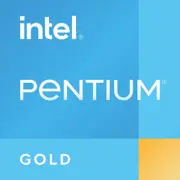Intel Pentium Gold 6405U

Intel Pentium Gold 6405U: Budget Processor for Everyday Tasks in 2025
Overview of Architecture, Performance, and Use Cases
Introduction
In 2025, budget laptops remain popular among students, office workers, and users who do not require extreme performance. One of these solutions is the Intel Pentium Gold 6405U processor, introduced back in 2020. Despite its age, it continues to be found in new entry-level devices. Let's explore what this chip is capable of and who it is suitable for.
Architecture and Technology Process
Comet Lake Features
The Pentium Gold 6405U is built on the Comet Lake architecture and a 14nm process that Intel has utilized since 2015. This generation was the last before the transition to 10nm technology (Ice Lake and Tiger Lake). Key specifications include:
- 2 cores and 4 threads thanks to Hyper-Threading.
- Base frequency: 2.4 GHz, no turbo mode.
- L3 cache: 4 MB.
- Integrated graphics: Intel UHD Graphics (10th generation) with 24 execution units and a frequency of up to 900 MHz.
Despite the outdated technology process, the chip is optimized for low power consumption. UHD graphics can handle 4K video decoding but are not suitable for gaming or 3D modeling.
Power Consumption and TDP
The processor has a TDP of 15W, which is typical for ultrabooks and thin laptops. This allows:
- Use of passive or compact active cooling.
- Achieving low noise levels.
- Installation of the chip in devices with a battery capacity starting from 40 Wh.
However, under sustained loads (for example, video rendering), throttling may occur due to overheating in budget cases with poor cooling systems.
Performance in Real Tasks
Office Work and Multitasking
- Microsoft Office, Google Docs: The processor works without delays even with several browser tabs and messaging apps open.
- Video Calls: Zoom/Teams consume up to 70% of resources but do not cause freezes.
- Multimedia: Watching 4K video (YouTube, Netflix) does not stress the system thanks to hardware decoding.
Gaming
Intel UHD Graphics only supports older, less demanding games:
- CS:GO: 720p, low settings — 25-35 FPS.
- Minecraft: 30-40 FPS without shaders.
- Indie Projects (Stardew Valley, Terraria) — stable 60 FPS.
The processor is unsuitable for modern AAA games (Cyberpunk 2077, Elden Ring).
Use Cases
The Pentium Gold 6405U is suitable for:
1. Studying: Working with texts, presentations, online courses.
2. Office work: Accounting software, 1C, email clients.
3. Everyday tasks: Internet browsing, streaming, social media communication.
4. Mobile devices: Compact laptops with long battery life (8-10 hours).
Not recommended for:
- Video editing (even at 1080p).
- Programming with heavy IDEs (Android Studio, Unity).
- Gaming beyond minimum requirements.
Battery Life and Power Saving Technologies
Under load, the processor consumes up to 12-15W, while idle consumption is 3-5W. Battery life depends on capacity:
- Laptop with a 42 Wh battery: 7-9 hours with moderate use (browsing, office tasks).
- In power-saving mode: up to 10-12 hours.
Intel Technologies:
- Speed Shift — fast switching between frequencies for energy savings.
- C-States — disabling unused cores.
- Dynamic Tuning — adaptation to load in real-time.
Comparison with Competitors
AMD Ryzen 3 3250U (14nm, 2 cores/4 threads)
- Advantages: Vega 3 graphics are 15% faster.
- Disadvantages: Higher power consumption (TDP 15W, but worse battery optimization).
Apple M1 (5nm, 4 cores/4 threads)
- M1 is 3-4 times faster in multi-threaded tasks, and graphics outperform UHD by 5 times.
- Laptops with M1 are more expensive ($700+ compared to $300-500 for Pentium).
Intel Core i3-1115G4 (10nm, 2 cores/4 threads)
- More modern architecture, higher IPC (15-20% performance increase in single-threaded tasks).
- Laptop prices start from $450.
Conclusion: The Pentium Gold 6405U is a choice for the most budget-friendly devices. Competitors offer better performance for a slightly higher price.
Pros and Cons
Strengths:
- Low cost of laptops ($300-500).
- Energy efficiency.
- Sufficient for basic tasks.
Weaknesses:
- Outdated 14nm technology process.
- No turbo mode.
- Weak graphics.
Recommendations for Choosing a Laptop
1. Type of Device: Ultrabook or budget laptop (for example, Lenovo IdeaPad 3, Acer Aspire 5).
2. Minimum Specifications:
- 8 GB RAM (mandatory!).
- 256 GB SSD (not HDD!).
- A screen resolution of 1920×1080.
3. Additional Options:
- IPS matrix for better viewing angles.
- Weight up to 1.5 kg for portability.
Avoid:
- Configurations with 4 GB RAM — this will lead to slowdowns.
- Laptops without SSDs.
- Devices with a 1366×768 screen.
Final Conclusion
Intel Pentium Gold 6405U in 2025 is a processor for those seeking the cheapest laptop for simple tasks. It is suitable for:
- Students for note-taking and online classes.
- Retirees who need a device for communication and reading news.
- Offices procuring equipment for employees.
Key benefits: low price, long battery life, sufficient performance for basic use. If your budget allows adding $100-150, it is better to choose a laptop with a Core i3 or Ryzen 3 — they will last longer and not disappoint in multitasking.
Basic
CPU Specifications
Memory Specifications
GPU Specifications
Miscellaneous
Share in social media
Or Link To Us
<a href="https://cputronic.com/en/cpu/intel-pentium-gold-6405u" target="_blank">Intel Pentium Gold 6405U</a>